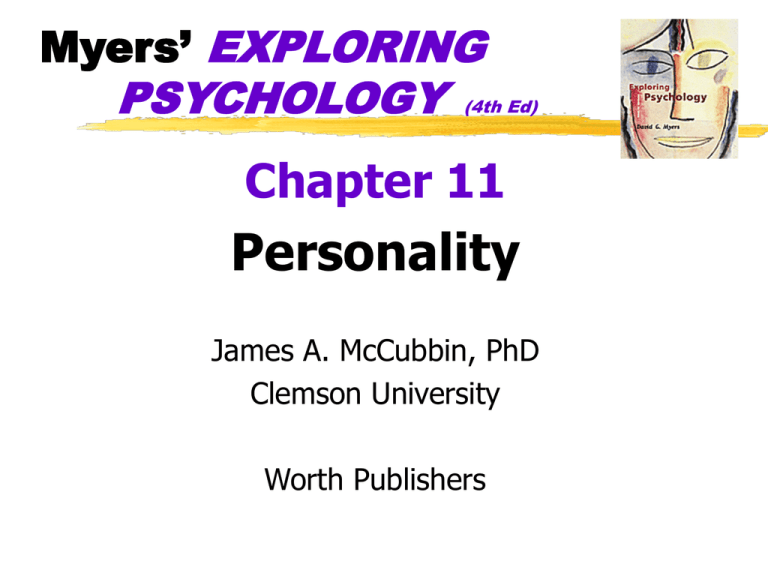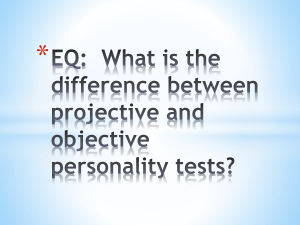Introduction to Psychology
advertisement

Myers’ EXPLORING PSYCHOLOGY (4th Ed) Chapter 11 Personality James A. McCubbin, PhD Clemson University Worth Publishers What is Personality? Personality an individual’s characteristic pattern of thinking, feeling, and acting four basic perspectives Psychoanalytic Trait Humanistic Social-cognitive The Psychoanalytic Perspective From Freud’s theory which proposes that childhood sexuality and unconscious motivations influence personality The Psychoanalytic Perspective Psychoanalysis Freud’s theory of personality that attributes our thoughts and actions to unconscious motives and conflicts technique of treating psychological disorders by seeking to expose and interpret unconscious tensions The Psychoanalytic Perspective Free Association method of exploring the unconscious person relaxes and says whatever comes to mind, no matter how trivial or embarrassing The Psychoanalytic Perspective Unconscious Freud-a reservoir of mostly unacceptable thoughts, wishes, feelings and memories Contemporary-information processing of which we are unaware Preconscious information that is not conscious, but is retrievable into conscious awareness Personality Structure Id a reservoir of unconscious psychic energy strives to satisfy basic sexual and aggressive drives operates on the pleasure principle, demanding immediate gratification Personality Structure Superego the part of personality that presents internalized ideals provides standards for judgement and for future aspirations Personality Structure Ego the largely conscious, “executive” part of personality mediates among the demands of the id, superego and ego operates on the reality principle, satisfying the id’s desires in ways that will realistically bring pleasure rather than pain Personality Structure Ego Conscious mind Unconscious mind Superego Id Freud’s idea of the mind’s structure Personality Development Psychosexual Stages the childhood stages of development during which the pleasure-seeking energies focus on distinct erogenous zones Oedipus Complex a boy’s sexual desires toward his mother and feelings of jealousy and hatred for the rival father Personality Development Freud’s Psychosexual Stages Stage Focus Oral (0-18 months) Pleasure centers on the mouth-sucking, biting, chewing Anal (18-36 months) Pleasure focuses on bowel and bladder elimination; coping with demands for control Pleasure zone is the genitals; coping with incestuous sexual feelings Phallic (3-6 years) Latency (6 to puberty) Dormant sexual feelings Genital (puberty on) Maturation of sexual interests Personality Development Identification the process by which children incorporate their parents’ values into their developing superegos Fixation a lingering focus of pleasure-seeking energies at an earlier psychosexual stage, where conflicts were unresolved Defense Mechanisms Defense Mechanisms the ego’s protective methods of reducing anxiety by unconsciously distorting reality Repression the basic defense mechanism that banishes anxiety-arousing thoughts, feelings, and memories from consciousness Defense Mechanisms Regression defense mechanism in which an individual retreats, when faced with anxiety, to a more infantile psychosexual stage where some psychic energy remains fixated Defense Mechanisms Reaction Formation defense mechanism by which the ego unconsciously switches unacceptable impulses into their opposites people may express feelings that are the opposite of their anxiety-arousing unconscious feelings Defense Mechanisms Projection defense mechanism by which people disguise their own threatening impulses by attributing them to others Rationalization defense mechanism that offers self-justifying explanations in place of the real, more threatening, unconscious reasons for one’s actions Defense Mechanisms Displacement defense mechanism that shifts sexual or aggressive impulses toward a more acceptable or less threatening object or person as when redirecting anger toward a safer outlet Sublimation rechanneling of unacceptable impulses into socially approved activities Neo-Freudians Alfred Adler importance of childhood social tension Karen Horney sought to balance Freud’s masculine biases Carl Jung emphasized the collective unconscious concept of a shared, inherited reservoir of memory traces from our species’ history Assessing the Unconscious Projective Test a personality test, such as the Rorschach or TAT, that provides ambiguous stimuli designed to trigger projection of one’s inner dynamics Thematic Apperception Test (TAT) a projective test in which people express their inner feelings and interests through the stories they make up about ambiguous scenes Assessing the Unconscious- TAT Assessing the Unconscious Rorschach Inkblot Test the most widely used projective test a set of 10 inkblots designed by Hermann Rorschach seeks to identify people’s inner feelings by analyzing their interpretations of the blots Assessing the Unconscious- Rorschach The Trait Perspective Trait a characteristic pattern of behavior a disposition to feel and act, as assessed by self-report inventories and peer reports Personality Inventory a questionnaire (often with true-false or agree-disagree items) on which people respond to items designed to gauge a wide range of feelings and behaviors used to assess selected personality traits The Trait Perspective Moody Anxious Rigid Sober Pessimistic Reserved Unsociable Quiet UNSTABLE Touchy Restless Aggressive Excitable Changeable Impulsive Optimistic Active melancholic choleric INTROVERTED EXTRAVERTED phlegmatic sanguine Passive Sociable Careful Outgoing Thoughtful Talkative Peaceful Responsive Controlled Easygoing Reliable Lively Carefree Even-tempered Leadership Calm STABLE Hans and Sybil Eysenck use two primary personality factors as axes for describing personality variation The Trait Perspective The “Big Five” Personality Factors Trait Dimension Description Emotional Stability Calm versus anxious Secure versus insecure Self-satisfied versus self-pitying Extraversion Sociable versus retiring Fun-loving versus sober Affectionate versus reserved Openness Imaginative versus practical Preference for variety versus preference for routine Independent versus conforming Extraversion Soft-hearted versus ruthless Trusting versus suspicious Helpful versus uncooperative Organized versus disorganized Careful versus careless Disciplined versus impulsive Conscientiousness The Trait Perspective Minnesota Multiphasic Personality Inventory (MMPI) the most widely researched and clinically used of all personality tests originally developed to identify emotional disorders (still considered its most appropriate use) now used for many other screening purposes The Trait Perspective Empirically Derived Test a test developed by testing a pool of items and then selecting those that discriminate between groups such as the MMPI The Trait Perspective Clinically significant range Minnesota Multiphasic Personality Before treatment (anxious, Inventory depressed, and (MMPI) test displaying deviant behaviors) profile Hypochondriasis 1 (concern with body symptoms) Depression 2 (pessimism, hopelessness) After treatment (no scores in the clinically significant range Hysteria 3 (uses symptoms to solve problems) Psychopathic deviancy 4 (disregard for social standards) Masculinity/femininity 5 (interests like those of other sex) Paranoia 6 (delusions, suspiciousness) Psychasthenia 7 (anxious, guilt feelings) Schizophrenia 8 (withdrawn, bizarre thoughts) Hypomania (overactive, excited, impulsive) 9 Social introversion 10 (shy, inhibited) 0 30 40 50 60 T-score 70 80 Evaluating the Trait Perspective Situational influences on behavior are important to consider People can fake desirable responses on self-report measures of personality Averaging behavior across situations seems to indicate that people do have distinct personality traits Humanistic Perspective Abraham Maslow (1908-1970) studied self-actualization processes of productive and healthy people (e.g., Lincoln) Self-Actualization the ultimate psychological need that arises after basic physical and psychological needs are met and self-esteem is achieved the motivation to fulfill one’s potential Humanistic Perspective Carl Rogers (1902-1987) focused on growth and fulfillment of individuals requires three conditions: • genuineness • acceptance - unconditional positive regard • empathy Unconditional Positive Regard an attitude of total acceptance toward another person Humanistic Perspective Self-Concept all our thoughts and feelings about ourselves, in an answer to the question, “Who am I?’ Self-Esteem one’s feelings of high or low self-worth Self-Serving Bias a readiness to perceive oneself favorably Humanistic Perspective Individualism giving priority to one’s own goals over group goals and defining one’s identity in terms of personal attributes rather than group identifications Collectivism giving priority to the goals of one’s group (often one’s extended family or work group) and defining one’s identity accordingly Humanistic Perspective Value Contrasts Between Individualism and Collectivism Concept Individualism Collectivism Self Independent (identity from individual traits) Interdependent identity from belonging) Life task Discover and express one’s uniqueness Maintain connections, fit in What matters Me--personal achievement and fulfillment; rights and liberties We--group goals and solidarity; social responsibilities and relationships Coping method Change reality Accommodate to reality Morality Defined by individuals (self-based) Defined by social networks (duty-based) Relationships Many, often temporary or casual; confrontation acceptable Few, close and enduring; harmony valued Attributing behavior Behavior reflects one’s personality and attitudes Behavior reflects social norms and roles Evaluating the Humanistic Perspective Concepts like self-actualization are vague Emphasis on self may promote self-indulgence and lack of concern for others Theory does not address reality of human capacity for evil Theory has impacted popular ideas on childrearing, education, management, etc. Social-Cognitive Perspective Internal personal/ cognitive factors (liking high-risk activities) Behavior (learning to bungee jump) Environmental factors (bungee-jumping friends) Reciprocal Determinism the interacting influences between personality and environmental factors Social-Cognitive Perspective Personal Control our sense of controlling our environments rather than feeling helpless External Locus of Control the perception that chance or outside forces beyond one’s personal control determine one’s fate Social-Cognitive Perspective Internal Locus of Control the perception that one controls one’s own fate Learned Helplessness the hopelessness and passive resignation an animal or human learns when unable to avoid repeated aversive events Social-Cognitive Perspective Built from research on learning and cognition Fails to consider unconscious motives and individual disposition Today, cognitive-behavioral theory is perhaps predominant psychological approach to explaining human behavior Personality- Summary The Four Perspectives on Personality Perspective Behavior Springs From Assessment Techniques Evaluation Psychoanalytic Unconscious conflicts between pleasure-seeking impulses and social restraints Projective tests aimed at revealing unconscious motivations A speculative, hard-to-test theory with enormous cultural impact Trait Expressing biologically influenced dispositions, such as extraversion or introversion (a)Personality inventories that assess the strengths of different traits (b)Peer ratings of behavior patterns A descriptive approach criticized as sometimes underestimating the variability of behavior from situation to situation Humanistic Processing conscious feelings about oneself in the light of one’s experiences (a)Questionnaire assessments (b)Empathic interviews A humane theory that reinvigorated contemporary interest in the self; criticized as subjective and sometimes naively self-centered and optimistic Social-cognitive Reciprocal influences between (a)Questionnaire assessments people and their situation, of people’s feelings of control colored by perceptions of (b) Observations of people’s control behavior in particular situations Art interactive theory that integrates research on learning, cognition, and social behavior, criticized as underestimating the importance of emotions and enduring traits







